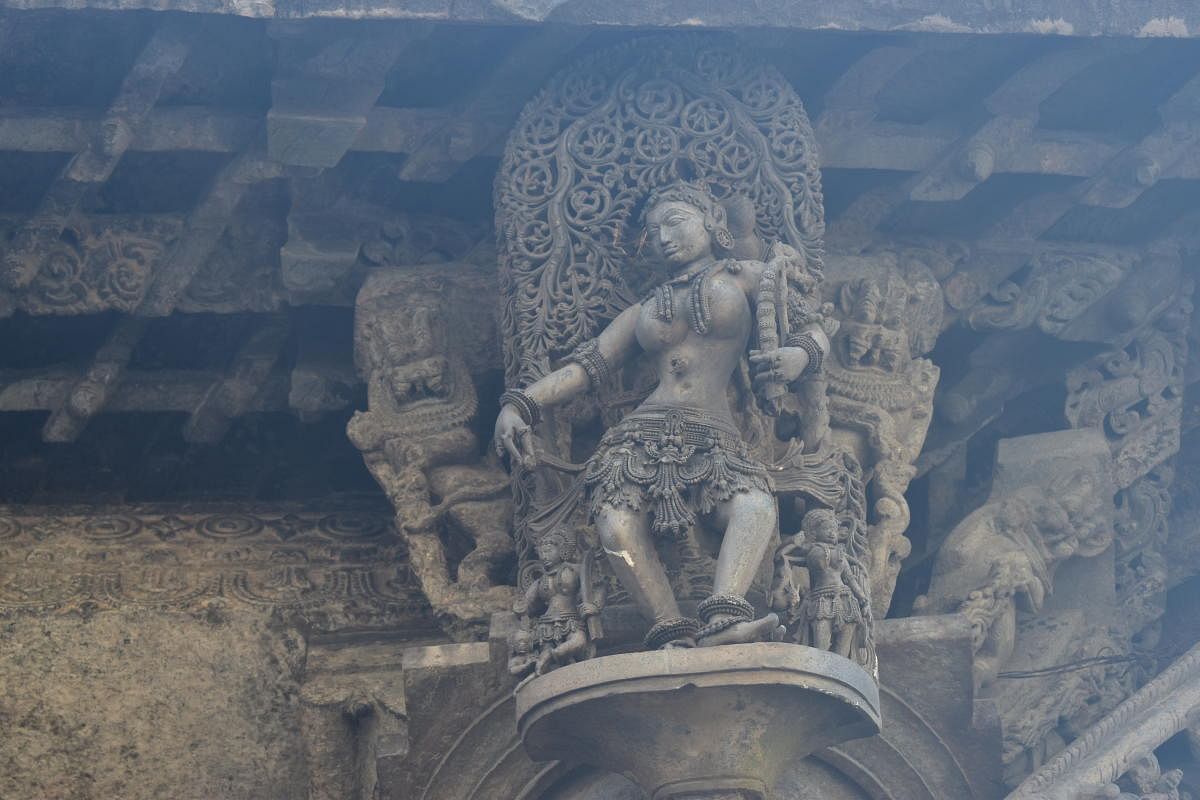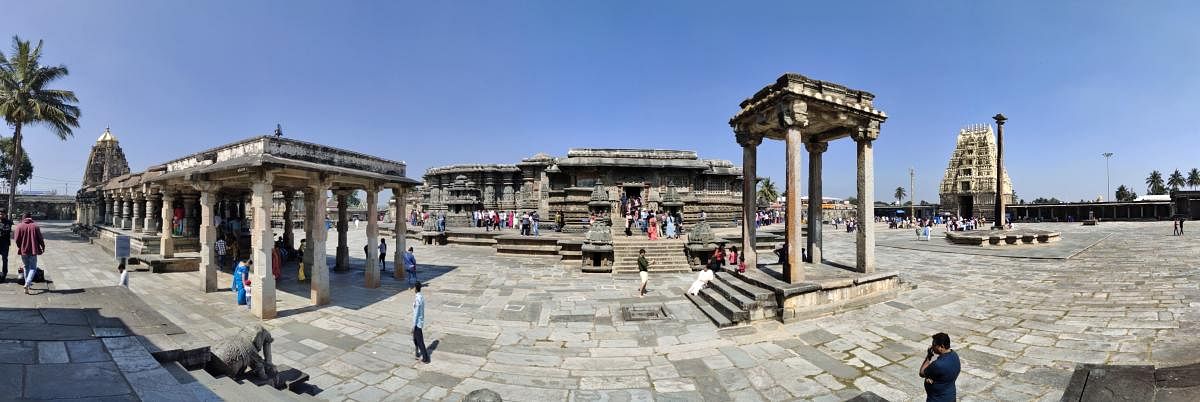

When Vishnuvardhana defeated the Cholas in 1116 CE, he commemorated the seminal victory by building a grand temple. Accomplished artisans were brought in from neighbouring kingdoms and soon, the capital thrummed with the sound of masons hard at work on the new temple in Belur.
One can imagine the stir when the Channakeshava temple was consecrated in 1117 CE, for it was a temple unlike anything anyone had seen.
It stood on a star-shaped platform. Its zigzagging walls were a visual feast, replete with large and ornate carvings of gods, goddesses and other divinities on each and every indentation. Its shikhara resembled those of temples in far-away central India (this shikhara was dismantled in the 1880s). And inside, the polished pillars and ornate roofs both vied for attention.
Just four years later, the merchant Ketamalla sponsored the Hoysalesvara temple in Halebidu, a double-shrined temple that rivalled Belur’s royal temple in every way.
Together, these two temples established a new style that was used in hundreds of temples built by kings, merchants, soldiers and commoners throughout the Hoysala regions for the next 150 years. The last grand Hoysala temple was built in 1268 CE by a military officer who commissioned the Keshava Temple in Somanathapura.
In 2019, the Department of Archaeology, Museums and Heritage tasked The Indian National Trust for Art and Cultural Heritage (INTACH), Bengaluru Chapter with preparing a nomination dossier to have the Sacred Ensembles of the Hoysalas inscribed on UNESCO’s list of World Heritage Sites. This dossier, prepared by a team led by INTACH’s conservation architect Pankaj Modi, was submitted to the Archaeological Survey of India, which submitted it to UNESCO in January this year.
The dossier lists the Channakeshava temple in Belur, the Hoysalesvara temple in Halebidu and the Keshava temple in Somanathapura as the best representatives of Hoysala sacred architecture.
It is not easy to distill exactly what makes Hoysala temples both outstanding and unique. Certainly, they are known for their profuse ornamentation and their joyous horror vacui, with walls and surfaces completely filled with sculptures in high relief.
Perhaps the best-loved examples of Hoysala virtuosity are the famed madanikas of Belur. My favourite is a madanika shown playing the flute. Rhythm animates this sculpture, with the musician’s garland and garments swinging away from his body as he sways to the music of his flute.
Equally remarkable are the many sculptures of drummers who are depicted adjusting the tension ropes of their instruments to change their pitch. Notice how the tension ropes are shown lifted away from the drum, how the drummer’s fingers are carved underneath the tension ropes.
In parallel with their technical mastery, Hoysala artists showed great creativity in translating religious beliefs and stories into sculpture.
The very walls of the temples are imbued with meaning. According to art historian Sarada Natarajan, the multi-level frieze on the temple walls represents the biosphere with its constituent elements from the land, water and air.
Elephants at the base symbolically bear the temple’s weight, followed by a band of lordly lions. Sinuous floral creepers represent the earth’s bounties. War horses and riders in the fourth level symbolise speed and military might.
Up next is a remarkable register depicting stories from the Hindu epics and puranas. While sculptures based on the Ramayana and Mahabharata are ubiquitous in Hindu temples, Hoysala artists had the novel idea of having these stories unspool as you do the pradakshina, thus deepening the religious experience of the circumambulation.
The last two registers on the multi-tier frieze depict makaras or stylised crocodiles, creatures of the waters, and birds, creatures of the air.
Above this microcosm of the world is a Hoysala piece de resistance, the depiction of the heavenly realm in the form of life-sized sculptures of gods, goddesses and other divine beings. Particularly in the Somanthapura and Halebidu temples, the entire wall serves as the artists’ canvas, as sculptures merge seamlessly one into the next.
There are hundreds of these large sculptures in each temple, and each one of them is a masterpiece. Some busy images teem with tiny figures, like the depiction of Ravana lifting and shaking Mount Kailasha. Others are restful compositions, like the dancing Saraswati. And there are unusual depictions like the partly anthropomorphic figures of the avatars of Vishnu in the Somanathapura temple. All are enriched with the Hoysala penchant for hyperreal detail and minutiae, with every bead, bangle or leaf blade carved with great attention.
Besides their unmatched sculptural excellence, Hoysala temples are exceptional for being the result of confident architectural eclecticism. Architects adapted, modified and experimented with features drawn from temple-building traditions elsewhere. For example, the two-tier sculptural bands of elephants and people in 11th century western Indian temples inspired the magnificent multi-level friezes characteristic of the Hoysala temples.
By combining technical expertise and virtuosity with innovative ideas, Hoysala architects built beautiful temples that are also richly experiential. When the time comes for the final selections of sites next year, one hopes UNESCO agrees that these temples are indeed of outstanding universal value and deserve to be declared World Heritage.
(Meera Iyer is the author of ‘Discovering Bengaluru’ and the Convenor of INTACH Bengaluru Chapter.)